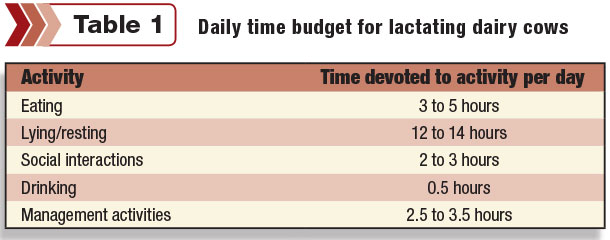Activity monitoring systems are becoming increasingly popular tools to help dairy farmers manage their herds and detect changes in cow behavior. One of the first applications of activity monitoring systems was for heat detection and breeding.
Many farmers report excellent satisfaction with this application, which has helped them improve pregnancy rates while reducing their reliance on reproductive hormones and other heat detection aids. The “next frontier” of activity monitoring is using the data generated by these systems to evaluate the lying and resting behavior of cows.
How a cow spends her days
Adult dairy cows have a “time budget” of the way they spend their time every day. Ideally, in a 24-hour period, cows should spend three to five hours eating in about nine to 14 separate meals. Other activities include lying down/resting, social interactions, drinking water and management activities (see Table 1).

Management activities include milking plus other tasks such as breeding and herd health exams. If these activities take longer than the ideal 2.5 to 3.5 hours per day, they cut into the time available for other activities. Long trips to the milking center, excessive wait times to be milked and cows left in lock-ups too long for management tasks all can rob them of precious eating and resting time.
When they have to choose, cows will sacrifice eating time to achieve their normal 12 to 14 hours of rest. Researchers have found for every 3.5 minutes of lost rest, cows will give up one minute of eating. As a result, this can lead to “slug feeding” behavior in time-strapped cows.
When they eat faster and chew less, cows generate less saliva, which impairs rumen fermentation, reduces feed efficiency and increases risk of ruminal acidosis. As a result, excessive standing time has been linked to elevated stress levels and reduced milk production.
Foot health also can suffer when time budgets are out of balance. Cows forced to stand or walk too long on hard surfaces are at greater risk for hoof problems such as sole hemorrhages, sole ulcers and laminitis.
Group, individual monitoring
Activity monitoring can first help managers achieve a baseline assessment of how cows in the herd are spending their time. If time allocations stray significantly from Table 1, management changes may be possible to bring time budgets into balance.
Such adjustments may include improving stall comfort, shortening parlor trips and wait times, and being mindful of the amount of time cows are held in lock-ups. One study showed preventing cows from lying down for a period as short as two hours was detrimental to resting behavior and cow comfort.
Heat stress also increases the amount of time cows stand. If herd standing behavior increases in hot conditions, more cow-cooling measures may be necessary. Feeding practices, including delivery and push-up sessions, can be evaluated and adjusted based on how they are shown to affect standing/lying behavior.
Individual-cow activity monitoring can be useful in drilling down to single-cow care. A cow’s time budget should be spent the same way every day. Heat cycles obviously will show up on individual animal reports, but subtle activity changes can be signals of other events.
Lame cows will have increased lying bouts and either longer or shorter lying time duration compared to the animal’s baseline behavior. Reduced step counts, which some systems also monitor, can indicate lameness as well.
Overcrowding and competition for stall and bunk space also can be detected using lying/resting data. First-lactation heifers should be monitored closely because they have been shown to be socially timid and lie down less than mature cows.
Research currently is underway to evaluate how activity monitoring devices can be used to monitor the health and well-being of transition cows in the weeks immediately before and after calving. Calving detection, along with identification of postpartum health problems like metritis and ketosis, are being explored for future application of activity monitoring data.
Next up: Mastitis detection
Detecting clinical mastitis and therefore improving herd health and milk quality is another emerging application of activity monitoring technology. A recent Canadian study evaluated the impact of induced E. coli mastitis on the resting/lying behavior of early lactation cows.
Twenty-one Holstein cows in their first three months of lactation were experimentally infused in one quarter with E. coli. Their lying time was evaluated for two days before and three days after infusion for total lying time, lying time on the side of infusion, number of lying bouts and average bout duration.
They found the infection had no bearing on the preference of side on which cows rested but did increase standing time, especially in the four to seven hours immediately after initiation of the infections. This reduction in lying time was concerning to the researchers because the sick animals actually needed more rest – not less – to recover from illness.
The researchers concluded monitoring of lying behavior could become an important component of early, on-farm detection of clinical mastitis, allowing cows to receive attention, therapy and supportive care more quickly in the future.
Applying the data
The value of activity monitoring data does not lie in the data itself but rather in the actions the data triggers. An essential part of adopting an activity monitoring system is to work closely with trusted herd advisers to develop protocols for generation of data reports, interpretation of the data (both who will interpret it and what factors will be monitored) and what actions will be taken based on observed changes.
Standard operating procedures and decision trees are very useful in training staff to give attention to cows flagged by data changes. Individual animal health assessments, treatment protocols and follow-up attention all can be defined in these plans.
The goals of nearly every dairy farmer who adopts an activity monitoring system are to create a streamlined work environment, increase efficiency and enhance herd health. Precise, reliable systems – coupled with plans for monitoring and reacting to data – can do all of those things for well-managed dairies. PD
PHOTO: One of the first applications of activity monitoring systems was for heat detection and breeding. The “next frontier” of activity monitoring is using the data generated by these systems to evaluate the lying and resting behavior of cows. Photo provided by GEA.
References omitted but are available upon request. Click here to email an editor.
James Bringe is a dairy equipment sales consultant with GEA Farm Technologies. Email James Bringe.






